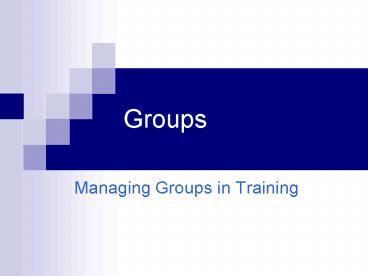Groups - PowerPoint PPT Presentation
Title:
Groups
Description:
Title: Managing Groups in Training Last modified by: Virtual Colleague Created Date: 5/17/2003 5:03:27 PM Document presentation format: On-screen Show – PowerPoint PPT presentation
Number of Views:49
Avg rating:3.0/5.0
Title: Groups
1
Groups
- Managing Groups in Training
2
Rationale
- Use of small groups is a very effective learning
technique and the cornerstone of cooperative
learning - You must be able to manage group interaction and
individual participation successfully to be
competent as a trainer.
3
Overview
- Stages of group development
- Group functions
- Importance of remaining aware of group dynamics
- Strategies for managing interaction and
participation successfully
4
Training participants GROUPS
- To improve our facilitation skills
- To meet our training objectives
- We need to understand and
- respond to how groups work!
5
Stages of Group Development
- Can you name them??
6
Stages of Group Development
- Forming
- Storming
- Norming
- Performing
- Adjourning
7
Forming
- Participants primary concern is to be included
- There is confusion about
- What to do
- How to interact
- Why the task before them is important
- Trainer can
- Give directions
- Clarify roles
- Encourage participation
8
Storming
- Participants now focus on being heard and having
control - Learners face conflicts as they
- Clarify issues
- Overcome indecisiveness
- Deal with power struggles
- Cope with impatience
- Trainer can
- Help group pinpoint dysfunctional behavior and
develop strategies to overcome them - Intervene as necessary to let group maintain
control
9
Norming
- Participants focus on being open and encouraging
- Typified by
- Spoken and unspoken rules about interactions
- Clear tasks and purposes
- Relief!
- Trainer can
- Raise questions challenging learners to grow
- Uncover unspoken issues
- Promote full exploration of ideas
10
Performing
- Participants achieve maximum productivity
- They move to solving problems
- Trainer can
- Check understanding and offer experience
- Offer positive reinforcement to preserve group
effectiveness - Encourage group to be self-facilitating
11
Adjourning
- Participants prepare to disband
- Trainer can
- Lead a debriefing of key points
- Help them plan how they will apply their new
knowledge, skills and attitudes in their work - Develop strategy to maintain the group
12
Group
- Dynamics
- Processes
- Functions
13
What do we mean by Group Dynamics
14
Group Dynamics
- Actions and interactions positive and negative
that occur when individuals become part of
groups
15
- Positive behaviors
- Help group become more effective
- Each individuals viewpoints and contributions
are sought out and valued - Negative behaviors
- Cause the group to be less effective
- Domination and ridicule are evident
- Trainer can
- Identify and isolate behaviors so that group
members interact effectively
16
Behaviors Needed for a group to Function
- Task
- These behaviors focus on WHAT the group is doing
- and on accomplishing the task/goal
- Maintenance
- Focus on HOW the group is doing
- The processes that make the group effective
17
Group behaviors
maintenance
task
- Initiating
- Clarifying
- Focusing
- Checking Consensus
- Seeking Information
- Giving Information
- Summarizing
- Moving Towards Action
- Reaching Task Agreement
- Gate Keeper
- Mediating
- Listening
- Encouraging
- Relieving Tension
- Diagnosing Difficulties
- Harmonizing
- Evaluating
18
Group Task and Maintenance Behaviors
- Trainer can
- Recognize all behaviors needed for groups to
function effectively - Model desired behaviors
- Ensure group dynamics remain positive
- Explicitly identify and explain functional
behaviors and their importance as needed - Recognize and remedy dysfunctional negative
behaviors
19
Strategies For Effective Group Processes
Introducing the Group Activity
- Provide thorough descriptions of directions
- Introduce purpose of activity
- State expectations
- Communicate time constraints
- Describe final product
- MONITOR small groups - provide additional guidance
20
Strategies For Effective Group Processes Use
Ground Rules
- Grounds rules are guidelines for interaction
norms - Encourage positive functional behaviors
- Solicit guidelines from the group itself dont
impose - POST the guidelines and refer to as needed
- Include additional norms on an ongoing basis as
needed
21
Strategies For Effective Group Processes Become
a Facilitator
- Manage interaction and participation that helps
groups become more effective - Choose appropriate instructional methods and
techniques - Help the group
- Define goals and objectives
- Create an open climate
- Facilitate problem solving
- Evaluate results
22
To work effectively with groups
- Develop facilitation skills
- Monitor interactions
- Plan creative interventions to support individual
participation - Plan the formation of subgroups
- Create and maintain structure for small group
assignments - Stop dysfunctional behaviors
23
What is your reaction to this information?
24
What did you learn? What are the implications of
what you learned?
25
How can you apply what you learned to you work?
What will you do differently in the future?
26
Think again write down at least three things
you want to remember about working with groups
- 1.
- 2.
- 3.
27
We hope you can now
- Discuss stages of group development
- State group functions
- Explain the importance of remaining aware of
group dynamics - Identify strategies for managing interaction and
participation successfully in your future work
with groups!































